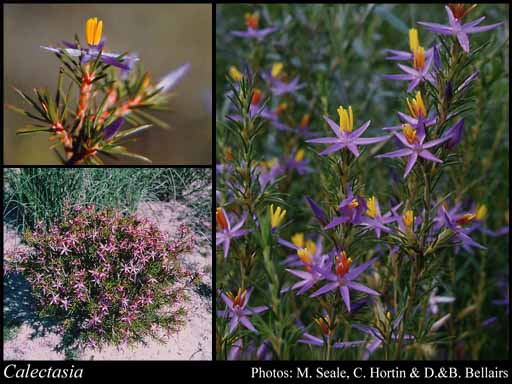- Reference
- Prodr.Fl.Nov.Holland. 263 (1810)
- Name Status
- Current







Scientific Description
Family Dasypogonaceae.
Sometimes included in Xanthorrhoeaceae.
Habit and leaf form. Shrubs, or herbs (shrublets); with disarticulating blades. Perennial (leaves persistent); rhizomatous (rhizomes short, compact). Xerophytic. Leaves small; alternate (spirally or irregularly crowded on the growing areas); spiral; imbricate; sheathing (the sheaths indurated, persistent). Leaf sheaths not tubular; with free margins. Leaves simple. Leaf blades entire; flat; linear, or lanceolate; ovate to linear; parallel-veined. Leaves without stipules. Leaf blade margins scabrid. Vegetative anatomy. Plants with silica bodies. Leaf anatomy. Hairs present (especially at margins, hairs branched). Extra-floral nectaries absent. Stem anatomy. Secondary thickening absent.
Reproductive type, pollination. Fertile flowers hermaphrodite. Unisexual flowers absent. Plants hermaphrodite.
Inflorescence and flower features. Flowers solitary; terminal (terminating short branchlets); very shortly pedicellate, or sessile; bracteate (the bracts surrounding the flowers, scarious); ebracteolate; medium-sized; regular; 3 merous; cyclic; pentacyclic. Perigone tube present. Perianth lilac of ‘tepals’ (to purple); 6; 2 -whorled; isomerous; joined; scarious but colourful; similar in the two whorls; blue, or purple (with an irridescent glossy metallic sheen). Androecial members definite in number. Androecium 6. Androecial members adnate (at the throat); all equal to markedly unequal (slightly unequal lengths distinguishing the whorls); free of one another; 2 -whorled. Androecium exclusively of fertile stamens. Stamens 6; all more or less similar in shape; diplostemonous; borne at the base of the lobes at the mouth of the perianth tube. Anthers more or less basifixed; terminally dehiscing via pores to dehiscing via short slits; introrse; tetrasporangiate; shortly lobed at the base. Gynoecium 3 carpelled. The pistil 1 celled. Carpels isomerous with the perianth. Gynoecium syncarpous; eu-syncarpous; superior. Ovary unilocular; 1 locular; sessile. Gynoecium stylate. Styles 1; attenuate from the ovary; apical; much longer than the ovary at anthesis. Stigmas 1. Placentation basal. Ovules in the single cavity 3; funicled; ascending; non-arillate; anatropous.
Fruit and seed features. Fruit non-fleshy; indehiscent; a nut; 1 celled; 1 seeded. Testa without phytomelan.
Geography, cytology, number of species. Australian. World distribution: Western and South Australia and Victoria. 1 species.
Additional characters Pollen grains sulcate.
Taxonomic Literature
- Wheeler, Judy; Marchant, Neville; Lewington, Margaret; Graham, Lorraine 2002. Flora of the south west, Bunbury, Augusta, Denmark. Volume 1, introduction, keys, ferns to monocotyledons. Australian Biological Resources Study.. Canberra..
- Barrett, Russell L.; Dixon, Kingsley W. 2001. A revision of the genus Calectasia (Calectasiaceae) with eight new species described from south-west Western Australia.
- Australia. Bureau of Flora and Fauna 1986. Flora of Australia. Volume 46, Iridaceae to Dioscoreaceae. Australian Govt. Pub. Service.. Canberra..